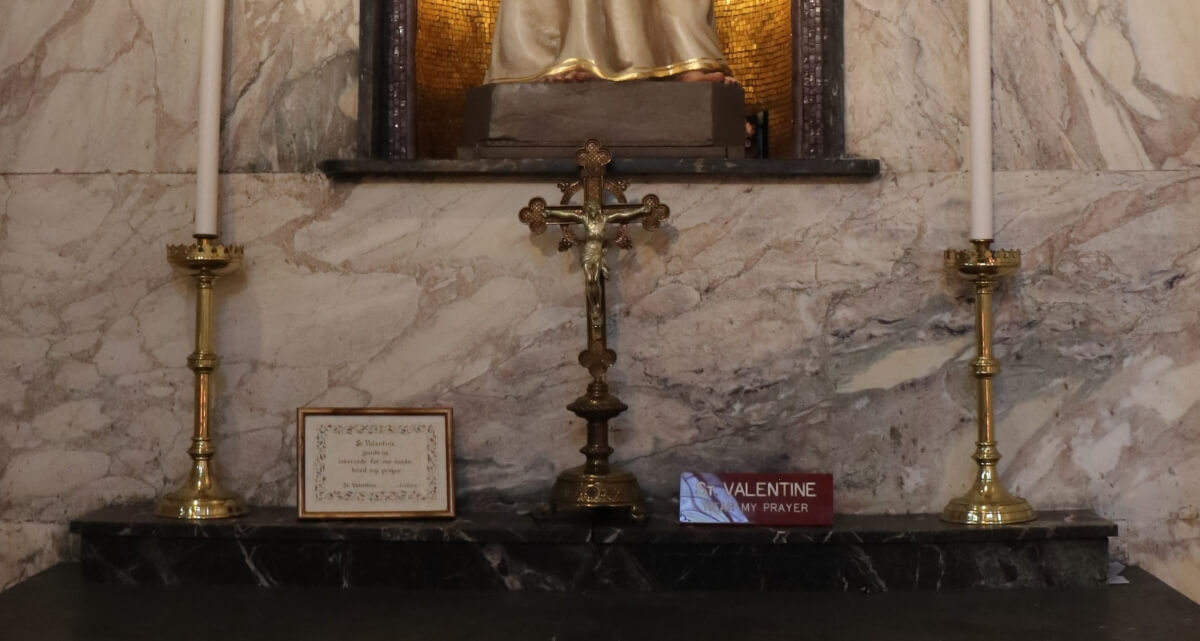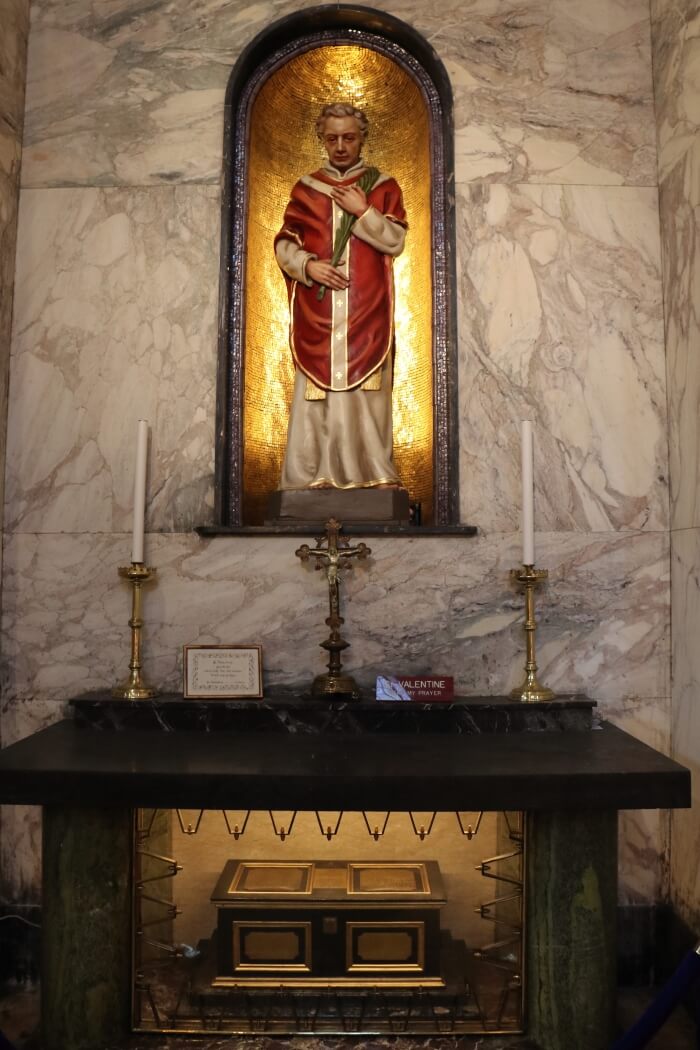
Chocolates, roses, or dinner for two at a nice restaurant are likely what comes to most of our minds when we think of Valentine’s Day.
Yet perhaps we have a limited perspective if this is all that our minds conjure up when Valentine’s Day comes around each year. Perhaps, in fact, by discovering the truth about the real St. Valentine, our vision will be expanded and we will have a new frame of reference for this feast and for the man who is an important saint for our times.
The image of Cupid might be somewhat to blame for our common misconceptions of St. Valentine. The angelic cherub and his arrow that causes the one struck to be filled with romantic love comes to us from classical mythology. Cupid, the god of desire, attraction, and affection is portrayed as the son of the love goddess, Venus, and the god of war, Mars. He is also known as Amor and in Greek mythology, Eros—who, during the Hellenistic period, was represented as a chubby little boy. This is where we get the vision of Cupid we still have today.
We can leave the mythological image of Cupid alone; he adds a whimsical note and still represents romantic love for couples—which is all well and good on Valentine’s Day. But Valentine himself was a real person; he died a martyr. And while his qualities have sometimes been infused with Cupid-like characteristics, his story and consequent feast day should be associated with the enduring strength and sacrificial love of marriage.

Perhaps this is prominently on my mind today because our daughter was recently married. During the wedding, our priest gave a profound homily explaining the sacrificial nature of married life, saying that those joining in marriage are asked to give to one another in the same way that Christ gave Himself for us all on the Cross.
No small words. These words are reflected in the stories told of St. Valentine himself.
Perhaps the best source for the truth behind St. Valentine is an unassuming Carmelite church in Dublin, Ireland. Whitefriar Street Church is in some ways an unlikely place for the relics of St. Valentine. But even its own story of the housing of his relics is an interesting one. I inquired about the church by writing to the administrator and was pleased to receive information about its history from its prior, Fr. Simon Nolan, O.Carm.
The Story of Whitefriar Street Church
Fr. Nolan explained that there was a certain Carmelite priest, Fr. Spratt, who became a somewhat prominent figure in the life of Dublin in the early 1800s. A tireless worker for the homeless and the poor, he founded schools, an orphanage, homes for the blind, and a night shelter. He was also a renowned speaker.
After a preaching tour of the churches of Rome in 1835, Fr. Spratt had an audience with Pope Gregory XVI. The Holy Father presented him with relics of St. Valentine, which had been taken from the Cemetery of St. Hippolytus in the Via Tiburtina.
“The gift was a token of the esteem of the Holy Father for Fr. Spratt but was also a gesture of solidarity with Catholics in Dublin and Ireland who had only just achieved emancipation from the discriminatory Penal Laws. Saint Valentine represented a direct link between the Church of Rome and the Church in Ireland which was emerging from the underground.”

“The Church of Our Lady of Mount Carmel, Whitefriar Street, had been completed in 1827 following the return of the Carmelite friars to Dublin and to the site of the original Carmelite Church and Priory which was founded in 1279 and dispossessed in 1539. The relics of Saint Valentine were brought to the new church in procession in 1836 and received by the then Archbishop of Dublin, Daniel Murray (1768-1852). They have remained at Whitefriar Street Church ever since.”
“The remains of Saint Valentine, martyr, together with a small vessel tinged with his blood. These are contained within a small wooden box, covered in painted paper, tied with a red silk ribbon and sealed with wax seals (which is the usual way in which relics are contained in reliquaries). This container is inside the casket which is seen beneath the altar. The outer casket has only been opened on a couple of occasions and then only to verify that the contents are intact and the seal unbroken. The inner box has not been opened or the seals broken since it left Rome in 1836.”

With the death of Fr. Spratt in 1871, interest in the relics died away and they were placed in safe storage. The current shrine of St. Valentine at the Church of Our Lady of Mount Carmel, Whitefriar Street, Dublin, dates from the 1950s. It features an altar with a glass front containing the casket reliquary of St. Valentine, and a statue of the saint by the noted Irish sculptor, Irene Broe (1923-1992), showing him in the red vestments of a martyr, holding the palm of martyrdom.
The Story of St. Valentine
But who is St. Valentine? And why is he a saint of the Church?
St. Valentine was a priest in Rome who was martyred during the 3rd century, though the Roman Martyrology actually lists two Italian martyr-Valentines under the 14th of February, one a priest and one a bishop, as well as an African martyr of the same name.
We don’t actually know much more for certain about St. Valentine’s life, but according to the legends that have come down to us, the emperor at the time issued an edict that prohibited the marriage of young people. At a time when young men were needed for the army, this proscription was based on the idea that unmarried soldiers fought better than married soldiers because the latter might be afraid of what might happen to their wives and families if they died.
This was also a permissive society whose views on marriage were far from the Christian one. In the midst of all of this, St. Valentine viewed marriage in the light of the Church—as a sacred bond between a man and woman for life. He understood that sacrifice was a major part of marriage and that married couples should therefore understand the sacrificial and sacramental aspects of the married state.
Some soldiers also held this notion of marriage and desired marriage, so St. Valentine would secretly marry them, defying the edict. Many couples flocked to him to be married.
On the 14th of February around the year 269, St. Valentine paid the ultimate price for his Faith. This is, of course, why the 14th of February is now his feast day. St. Valentine stands not only as a witness to the sanctity of love and marriage but also as a defender of freedom of religion.
A Saint for Our Times
Marriage isn’t always easy; far from it. Today marriage and family life are under attack as never before. As I think about my newly-married daughter and her husband (and all of my married children and their spouses), I realize that, in their married lives as well as my own, we only experience the sacrificial nature of marriage with the help of God’s grace. Let us ask Him now for that special grace that comes from the holy Sacrament of Marriage so that, in good times and in bad, we may always rely on Him.
St. Valentine, pray for us!
Prayer to St. Valentine:
Saint Valentine,
true servant who shed his blood
in defence of the sacraments and faith in Jesus Christ,
intercede for us today, we pray.
Gain for us the strength to be steadfast like you
in witnessing to the true faith to the end of our days,
and help us never to lose hope in the Lord
who is always near us.
Intercede for those men and women who are preparing for marriage:
help them to know one another and the true meaning
of the sacramental bond they are preparing to enter.
Intercede for those who are joined together
in the sacrament of marriage,
that they may never give up when trials come their way
but may remain faithful to each other,
and to the Lord who blessed their union.
May your love for the Lord be an inspiration for
our love for each other, for the love between husband and wife,
and for the love and charity we extend to all whom we meet.
Amen.
(Prayer taken from the Whitefriar Street Church website)
Had you ever heard the real story of St. Valentine?
How will you make this great saint a part of your Valentine’s Day celebrations?
Let us know in the comments below!






![St. Justin Martyr Describes The Catholic Mass in 155 A.D. [Video]](https://www.goodcatholic.com/wp-content/uploads/2021/01/Screen-Shot-2021-09-20-at-4.38.13-PM-350x197.png)
